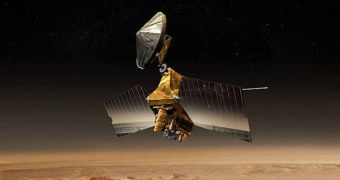The American space agency's Mars Reconnaissance Orbiter (MRO) has been recently pulled out of its safe mode state, and has returned to making highly detailed scientific observations. The announcements were made by experts at the Jet Propulsion Laboratory, in Pasadena, who manage the mission for NASA. All six science instruments currently aboard the spacecraft are functioning within the expected parameters, and mission managers say that the computer systems seem to have recovered well from the glitches they experienced four times this year alone.
“It's good to have the instruments back on. This has been a long stand-down. Now we're ready to resume our science and relay mission,” JPL expert and MRO mission manager Dan Johnston says. In addition to surveying the surface of the Red Planet with great accuracy, the mission is also acting as a relay for the MER components Spirit and Opportunity. This allows the two rovers, which have been driving on the planet for more than five years each, to retain more of their diminishing solar-power reserves, and no longer use their high-gain antennas to send data back to Earth, the experts say.
“The orbiter's six instruments will continue examining the atmosphere, surface and subsurface of Mars, including areas of interest as potential landing sites for future missions. It is northern spring in the northern hemisphere on Mars, and we are eager to take advantage of the good visibility provided by the relatively dust-free atmosphere present at this season. A major goal of the mission is to look at changes on Mars. For example, the instruments will observe the changing polar caps, examining the extent and composition of the retreating north polar frosts and the growth of the south polar cap during this period,” MRO project scientist Rick Zurek, also from the JPL, adds.
Erickson says that the upload sequence for the new pieces of software – that were just sent to the spacecraft – began on Monday, November 30, and that all the needed data reached the MRO over the next few days. This is not the first time when the orbiter ceased operations. The three other instances when the computers on MRO shut down were recorded on February 23, June 4 and August 6. The fourth and final one, which saw the safe mode being left in place for longer, took place on August 26.
The JPL team discovered in its investigation that the main culprit that was responsible for the four reboots was a piece of equipment known as the “computer module interface controller.” This device basically controls which of the two computer systems aboard the MRO is in control of the spacecraft at all times. The engineers believe that the issue resided either in the controller itself, or in a voltage glitch that hampered with its normal operations.
The NASA Jet Propulsion Laboratory manages the Mars Reconnaissance Orbiter for NASA's Science Mission Directorate, in Washington DC. Denver, Colorado-based Lockheed Martin Space Systems built the spacecraft. The JPL is a division of the California Institute of Technology (Caltech), in Pasadena.

 14 DAY TRIAL //
14 DAY TRIAL //